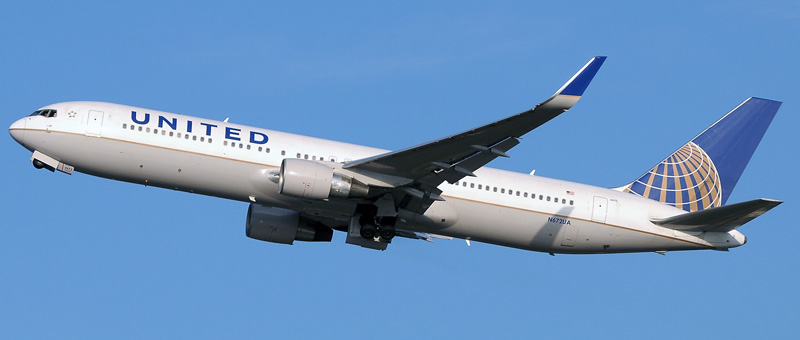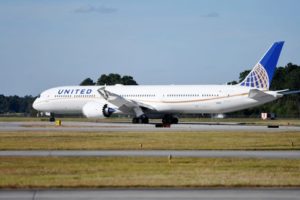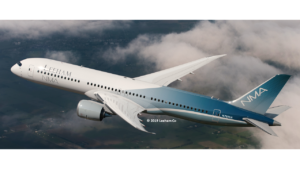Leeham News and Analysis
There's more to real news than a news release.
“It’s not easy to compare:” Airbus’ CEO Faury
- Guillaume Faury has been the chief executive officer of Airbus Group since April 1. In this exclusive interview, he looks back on his first six months and ahead for the future of the company. Part 1 appeared Oct. 30. This is the second of two parts.
Nov. 6, 2019, © Leeham News: “It’s not easy to compare the performance of the two companies,” says Guillaume Faury, the CEO of Airbus, when the inevitable comparisons between his company and Boeing are made.
The context was talking about advanced manufacturing, discussed in Part 1 of this interview.
“I don’t think we are behind on digital. I think they might have gained more preparation on the future of production systems. We are catching up big time if not ahead in some important places. I think we will know who’s first when the next generation of airplanes is launched. These will be the first ones with digital design and manufacturing. There’s not a single plane today which is full DDMS.”
The issue is key to the next new airplane produced by Airbus or Boeing.
Is reengining the Boeing 767 a good idea? Part 3.
By Bjorn Fehrm
Subscription Required
Introduction
October 31, 2019, © Leeham News: We have looked into what a reengining of the 767 with GE GEnx engines would give over the last two weeks. FlightGlobal wrote Boeing considers reengining the 767-400ER with the GEnx engine to produce a new freighter and perhaps a replacement for the NMA project.
We analyzed the aircraft fundamentals in Part 1, then passenger and cargo capacities in Part 2 and now we finish with the economics of different possible variants compared with the standard 767 and a possible NMA.
Summary:
- The economic improvement of a GEnx reengined 767 is hampered by the new engine’s larger size and higher weight.
- After catering for the increased empty weight and drag of a reengined 767, the result puts the project in question.
- A reengined 767 is far from a replacement for the NMA.
Faury looks to transform Airbus
- Guillaume Faury has been the chief executive officer of Airbus Group since April 1. In this exclusive interview, he looks back on his first six months and ahead for the future of the company. This is part 1 of two parts. Part 2 will appear soon.
Oct. 30, 2019, © Leeham News: Guillaume Faury assumed his office as chief executive officer of the Airbus Group at a time when the company was trying to emerge from years-long scandals over bribery and corruption probes and the industry was only beginning to reel from the grounding of the Boeing 737 MAX.
Now, he’s focused on guiding Airbus in the future through a series of transformations to put the scandals behind the company, change production for the future and prepare for new airplanes that inevitably must be designed.
Becoming CEO
Faury’s been with Airbus for 20 years, surrounding a four-year stint with Peugeot from 2009-2013 as EVPO of Research and Development. He was named president of Airbus Commercial in February 2018. He previously was president and CEO of Airbus Helicopters from 2013-2018.
He succeeded CEO Tom Enders, who was not going to be given another term as part of the fallout of the numerous government investigations into past practices at Airbus involving third parties for aircraft sales, bribery and corruption allegations.
Although Enders and CFO Harald Wilhelm initiated the probes and reported the problems to the governments, they along with many others had to go as Airbus tried to limit the damage.
Is reengining the Boeing 767 a good idea? Part 2.
By Bjorn Fehrm
Subscription Required
Introduction
October 24, 2019, © Leeham News: According to FlightGlobal, Boeing is investigating reengining the 767-400ER with GE GEnx engines to produce a new freighter and perhaps a replacement for the NMA project.
We started an analysis of what this would look like last week where we analyzed the aircraft fundamentals. Now, we continue with the capacities of passenger and cargo variants. Summary:
Summary:
- The 767-400ER is one size larger than the largest NMA. It would be a competitor to the Boeing 787-8. This makes the variant doubtful as an NMA replacement.
- As a cargo variant, it adds less than 20% of cargo volume on top of the present freighter, the 767-300F. Is this attracitve enough to motivate a reengine for a freighter?
Is re-engining the Boeing 767 a good idea?
By Bjorn Fehrm
Subscription Required
Introduction
October 17, 2019, © Leeham News: FlightGlobal writes Boeing is investigating re-engining the 767-400ER with GE GEnx engines to produce a new freighter and perhaps a passenger aircraft as a replacement for the NMA project. Development costs would be lower and it would be easier to get a business plan which closes for the upgraded 767 than for the NMA.
We commented on the idea earlier in the week and here follows a technical analysis of what re-engining the 767 would bring.
Summary:
- The 767 is 40 years old in its base design. We look at the fundamentals to understand the trades involved in extending its life with new engines.
- We also compare the 767 technologies with those for the NMA to understand the compromises of an updated 767RE compared with a clean sheet NMA.
Opportunity and challenges of a 787-10ER
Subscription Required
By Vincent Valery
Introduction
Aug. 22, 2019, © Leeham News: By 2024 the 777-300ER will have been in service for 20 years and the 777-200ER 27 years.
LNA was the first to report the 777-8 entry-into-service will slip by at least two years. Boeing confirmed a delay in the 777-8 development, but not the timeline. Further delays (or an outright cancellation) for the passenger 777-8 are a real possibility. Boeing faces the prospect of not having a latest generation offering in the 330-370 seat market at a time demand for such aircraft is expected to pick up.
As part of the Air New Zealand commitment to purchase eight Boeing 787-10s, Boeing and General Electric are increasing the maximum takeoff weight to add more range.
In a similar fashion to the 777-300ER 20 years ago, Boeing might improve the 787-10 further to turn it into a fully-fledged ER variant. We will analyze the rationale for launching such variant and the challenges Boeing needs to overcome.
Summary
- Remediate a product gap
- Opportunities arising from surging 777 retirements
- A mixed track record of previous stretches and range improvements
- Target range for the 787-10
- Challenges associated with achieving those targets
Read more
Boeing’s Long Term Cash Flows
Subscription Required
By Vincent Valery
Introduction
Aug. 19, 2019, © Leeham News:Boeing’s long-time priorities, adopted after the 787 program finally was past its troubles, is shareholder value.
Boeing has spent tens of billions of dollars over the years in stock buybacks. It has regularly increased dividend payments.
In the context of a global aviation boom, the Commercial Airplanes division has generated the bulk of cash flow growth in recent years for the company. The creation of Boeing Global Services is a move toward achieving mid-teen margins for The Boeing Co.
Just like any aircraft OEM, the ability to generate cash flows rests on having an up-to-date and desirable product line up for customers.
 Before the Ethiopian Airlines Boeing 737 MAX crash, things were looking good for Boeing. Assuming a successful resolution of the 737 MAX crisis, Boeing should return to generating strong operating cash flows afterward.
Before the Ethiopian Airlines Boeing 737 MAX crash, things were looking good for Boeing. Assuming a successful resolution of the 737 MAX crisis, Boeing should return to generating strong operating cash flows afterward.
However, how long is the current product line up expected to sustain those cash flows and what could Boeing do about it?
Summary
- Dreamliner: from costly delays to cash flow machine
- Boeing 777 provided strong cash flows at critical time and 737 rode global aviation boom until grounding
- Significant production gaps on 737, 777 and 787 appear from mid 2020s, potentially threatening cash flow generation
- New variants, derivatives and clean sheet design would sustain cash flows longer.
Read more
How much of an NMA market will the Airbus A321XLR capture, Part 3?
By Bjorn Fehrm
Subscription Required
Introduction
August 1, 2019, © Leeham News: We wrap up our study of what part of an NMA market the Airbus A321XLR could capture with looking at the difference in available engine technology between the A231XLR and the NMA generation of airliners.
Summary:
- The generational improvement in fuel efficiency of airliner turbofans has been over 10% in the last decades.
- We examine if these improvements will still be the case for the NMA generation of aircraft.
How much of an NMA market will the Airbus A321XLR capture? Part 2
By Bjorn Fehrm
Subscription Required
Introduction
July 25, 2019, © Leeham News: We continue our discussion from last week of what part of an NMA market the Airbus A321XLR would capture.
We started the study by comparing the aircraft with a common yardstick. It brought some revealing insights. Now we continue by looking at the airline routes these aircraft can cover and their economics when covering these routes.
Summary:
- The NMAs and the A321XLR cover the same routes with small differences in range performance.
- The major difference is in their passenger capacity, where they are complementary rather than competitors.
Trans-Atlantic market fragmentation hurts big widebodies
Subscription Required
Now open to all readers
By Vincent Valery
July 22, 2019, © Leeham News: Development of single-aisle aircraft that now have ranges of plus-or-minus 4,000 nautical miles are fragmenting hub markets needed to fill large twin-aisle aircraft.
Just as twin-engine widebodies began fragmenting routes needed to fill the Boeing 747 and later the Airbus A380, the Boeing 737-8 and Airbus A321LR/XLR appear to be contributing to weak demand for the Boeing 777X and Airbus A350-1000.
With launch of the Airbus A321XLR last month and expected New Midsize Airplane once the MAX crisis is over, some markets might have structures dramatically altered in the second half of next decade. The prime candidate is the US East Coast–Europe market. We will investigate through historical examples how things might turn out.








